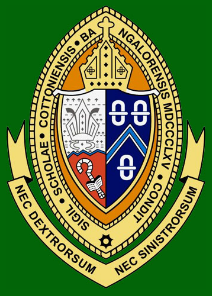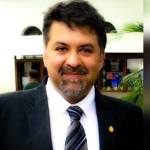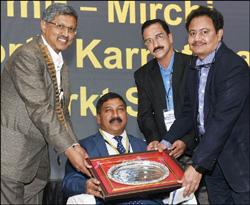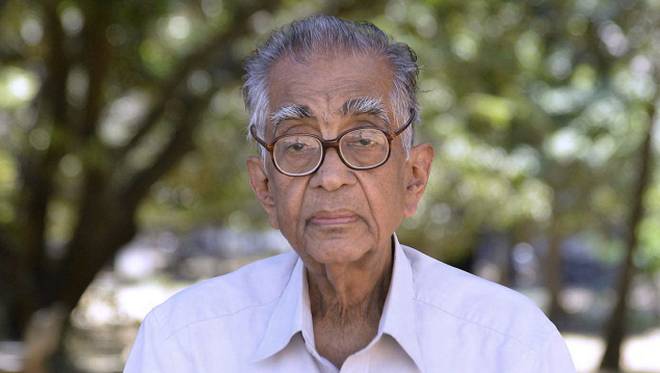The documentation of local culture in India is a vanishing art, especially in the English language. There are few go-to resources to get the real feel of the sights, sounds and smells of our cities, towns and villages.
Result: click-bait stuff dredged up by search-engine algorithms—“10 best biryanis in Bangalore”—is all there is to find on the world wide web.
Senior advocate Aditya Sondhi, currently an additional advocate-general for Karnataka, went to Bishop Cotton Boys’ School in Bangalore, and has written two books on his old school: Unfinished Symphony (2003) and The Order of the Crest (2015).
In this excerpt from The Order of the Crest, he writes about the role Old Cottonians, past and present, have played in crafting the “edgy, new vibe” that has made Bangalore the new melting pot.
***
‘Then, with the encouragement and help of Canon Elphick and Dewan Bahadur K. Matthan, the well-known café and store on St. Mark’s Road was started in 1952-53.’
from Maya Jayapal’s Bangalore: The Story of a City on how Koshy’s was born
****
by ADITYA SONDHI
In referring to M/s Elphick, Matthan and Koshy, Maya Jayapal actually refers to many stories within a story. The cantonment of Bangalore emerged only in the early part of the nineteenth century and that is when the city began to develop its colonial flavour.
By 1952, the city was well and truly bifurcated into the largely British/Anglo-Indian ‘cant’ and the native City or ‘pete’ areas.
There was no love lost between the two as well.
In some ways Koshy’s became the ‘common area’ for the old city and the cantonment to meet sans any protocol.
The intriguing part is how Cottons related to the blossoming of the city.
Dewan Bahadur K. Matthan felt compelled to admit nine out of ten of his children to the Bishop Cotton (boys and girls) Schools in the 1920s and later join the board of governors mainly on account of his rapport with warden Canon Elphick.
This broke a certain glass ceiling in that a prominent Indian Syrian Christian family was closely associating with the school. Another prominent member of the Syrian Christian community, Rajasabhabhushana K. Chandy had done so too.
That M/s Elphick and Matthan could prevail upon the late P. Oomen Koshy is not surprising in that he was an old boy, a Syrian Christian and at a loose end at that point of time.
Koshy’s has gone on to become a hoary part of Bangalore’s history, just like the school.
The next generation, Santosh and Prem have continued the legacy, being Cottonians and keeping the restaurant running in top form. (Prem is also a gifted actor and singer, and a compelling story-teller.)
And here is where the tapestry of the school and city meet.
Its people, institutions and culture have in a small but tangible way rubbed off each other. The Bangalore Club was founded two years before the school in 1863 and shares a wall with the school on Residency Road.
These have in some ways become twins, considering their trajectory and the fact that OCs have heavily populated the membership and control of the club. (And the fact that parts of it are still ‘for gentlemen only’!)
More significant is the fact that the club was started as the Bangalore United Services Club for serving officers of the Raj, many of whom sent their sons to neighbouring Bishop Cotton, which on its part was founded to cater to the needs of the Civil and Military Station.
General K.S. Thimayya as a young boarder is known to have gazed wistfully at the wild Saturday night dances at the club from his dormitory window in the 1920s. (PCs in the 1960s were mind-boggled to find that Timmy could still spot the loose grill in the window from whence many a furtive escape would have been made!)
With the passage of time, both, the club and school, transitioned from being ‘all-White’ and began to (selectively) let in Indian members. These were not necessarily ‘military admissions’, and several trading (and royal) families began partake in these places. Today, both of them are well and truly enmeshed with the city, but still struggle to ward off the ‘elitist’ tag.
Cottons has had a subtle touch on other institutions too.
Bangalore Little Theatre debuted in the school hall. The Bangalore School of Music had old boy Dr. Raja Ramanna as one of its earrliest patrons. St. Mark’s Cathedral is the literal sister institution with the wardens previously serving as ex officio chaplains and the boarders (still) worshipping there every Sunday.
The British Council was housed above Koshy’s as a tenant. The Green and Gold Ball was held at Bowring Insitute for many years. The Queen’s statue (and that of and King) in Cubbon Park were put there by an OC.
The old rivals have not been spared too.
Baldwins was founded by an Old Cottonian and the famous Webbs ground that doubled up as the sports field of St. Joseph’s belonged to old boy, John Webb. The first commandant of King George’s (Military) School, Bangalore was an old boy. The first student to be admitted to Stracey Memorial was a boy who moved across from Cottons.
South Parade in the 1880s had an unmistakable Cottonian connection. Old boy Walter Abraham, an honorary magistrate, founded the auctioneering firm Abraham and Co. The local businesses, the bank and the Bowring Institute closed shop for the day as a mark of respect when he passed away.
Colonel Percy Alfred Barton (OC) for many years ran Barton & Sons. This now houses Barton Centre. Barton was one of the founder members of the Rotary Club of Bangalore and also served on the board of governors of the school. A stickler for transparency, he would write letters as chairman of the OCA to himself as MD of Bartons when the association needed some silverware!
Webbs, of course, was next door. (Colin and Olive) Dozey’s Garage became a veritable hangout for Cottonian chinwag. Later, EGK (Venkatesh and Jaideep Ellore) and Jamaals (Ameen) joined the ‘M.G. Road Battalion’.
On South Parade was the unforgettable Plaza theatre belonging to OC Ananth Narrain and his family – descendants of the Arcot Narainswamy Mudaliars who run the RBANMS Educational Charities.
Many old and now non-existent theatres were in Cottonian hands.
Galaxy (Rehman), Symphony (Kapurs) Urvashi (Amit Gowda) and Nartaki & Lavanya (Shindes) for instance. (Bangaloreans also flocked to the Liberty cinema on South Parade circa 1958 because local boy Don Anderson, OC starred in Hugo Fregonese’s Harry Black and the Tiger!)
The one theatre that stands tall is Rex. Also owned by the Kapurs, it is one the few single-screen halls (thankfully) still in existence in Bangalore.
For this, OC Anil Kapur needs to take a bow. He is a passionate businessman and a passionate Cottonian. Which is not surprising, considering the number of boys and generations from his family that went to Cottons.
Along with the Kapoors (Union Street), Matthans and the Peerans, the Kapurs must hold the record for the maximum number of Cottonians produced. I am pretty sure several other families will be happy to stake their claim too.
OCs have marked their territory on adjoining Brigade Road too. Radio Shack is run by Suhail Yousuf who is also the president of the Brigade Road Traders’ Association.
Some of the Nilgiris’ family were also from the school.
S.J.P. road is speckled with establishments run by old boys.
Union Street and neighbouring Russel Market have the offices of Ameen Shacoor and Jansons (Akmal Jan). Shacoor’s has now yielded to a high-rise commercial outfit.
The India Garage has lodged itself as a monument on St. Mark’s Road. Owned by the ‘Vellore family’ whose V.K. Surendra, V.P. Mahendra, V.T. Thiruvendaswamy, V.V. Vijayendra, V.P. Thirumurthy and A.T. Nahender are all old boys. As was the patriarch V.T. Krishnamoorthy, the second son of V.S. Thiruvengadaswamy Mudaliar after whom the family–run VST Group is named.
The group is a massive conglomerate of petroleum, automobile and construction businesses, and is equally well-regarded for its CSR efforts in the city. The VST folks have also steered the fortunes Bangalore’s social, golf and motor racing clubs with poise. The eclectic Raintree stands on their property.
Commercial Street has been infiltrated as well. The Green Shop which made the school blazers and crests (Junaid Mahmood), Clifton’s (Azhar Sulaiman and family), Mysore Saree Udyog (brothers Kamlesh and Dinesh Talera) and Men’s Favourite Shop (Chatlanis) have been (and in some cases, remain) prominent landmarks of the bustling street.
The imperial jewellery store, C. Krishniah Chetty & Sons was founded a little after the school in 1869, and has had at least two generations pass through its portals. C.V. Hayagriv and C.V. Narayan looked after it with acclaim and now their respective sons, Vinod and Ganesh are following suit.
Woody’s which stands bang centre on Commercial Street used to be Rubin Moses’ eponymous shoe-shop. (Winston Churchill was one of his many loyal clients.) Moses’ son Sydney is an old boy and distinguished himself as a horse trainer. They are one of the few remaining Jewish families in Bangalore.
Together with the Jews, Bangalore has been home to many other ethnic groups, who have shared a relationship with Cottons.
The Kodavas have for long sent their sons to Bangalore (or to Lovedale, Ooty) and several prominent Kodava families are proud Cottonians.
The Chittiappa brothers (of whom Puttu was instrumental in organizing the acclaimed inter-family hockey tournament in Coorg) come to mind, along with a running list of many others who went on to serve the armed forces with great merit.
The others reverted to native Madikeri to look after their plantations and bring the house down at the North Coorg Club. Ram Bopiah has done both with acclaim! The Hurricane Stud Farm, founded by OC Kumar Siddanna is the only stud farm in Coorg.
A veritable melting-pot, Cottons has seen several of the prominent, immigrant Muslim groups admit their wards in the school.
The Persians (Khaleelis, Shirazis), the Deccanis (Mekhris) and the Cutchis (Saits), for instance.
The grandsons of Haji Sir Ismail Sait were in Cottons in the 1920s and as Eric Stracey recalls in his memoirs ‘lived in an imposing house … and sported a Jaguar’.
Zackria Hashim Sait serves as the president of the Cutchi Memon Jamath. Fellow Cutchi, Feroz Sait (Safina Plaza) is a prominent face in the turf club circuit. His namesake Feroze Abdullah Sait (Feroze’s Estates) holds an annual ‘harmony lunch’ on Eid that has become a symbol of the secular spirit of Bangalore.
The Parsis are equally well entrenched with Cottons.
Dara Shroff founded Shroff’s Realtors in the 1950s and is considered to be the patriarch of real estate in Bangalore. Some of the prominent landmarks in Whitefield were acquired by his clients at a time when those parts were a trunk-call away!
Dinshaw Cawasji is the president of the Bangalore Parsee Zoroastrian Anjuman. A graduate in English from the St. Olaf College, Minnesota, he returned to manage the Bai Dhunmai Cawasji High School and sanatorium founded by his grandfather Late Seth D. Cawajsi.
His predecessor as president of the Anjuman was Bishop Cotton comrade Phiroze B. Bharda. The sons of the high priest Dastur Nadirshah Pestonji Unvalla – Adil and Yezdi – are also old boys, the latter having served as honorary treasurer for a few terms.
Eminent planter-families from Chikmagalur (Jayarams), Goans (de Mellos), Sri Lankans (Jaysuryas) and royalty from the Deccan (House of Banganapalle, Sachin, Sandur) and West India (Bhonsles, Thorats, Ghatges) have all engaged with the school with purpose.
Sivaji Ganesan sent his sons and nephews across from Chennai being impressed with the turn-out of some PCs he met on a flight.
The Devanesens of Chennai had already beaten them to it.
Many of the affluent Dindigul families insisted on their sons being groomed at Cottons. S. Devnraj was one such loyal old boy from the 1950s. Many boys came down from Sikkim, Assam, Nagaland, (more recently) Jharkhand and even Africa, Burma and Tibet.
Expectedly, the critical mass of students to have entered Bishop Cotton were the British, Anglo-Indians and other Protestant families associated with the Church of South India.
Most books on the Anglo-Indian community are replete with references to Cottonian families such as the Robinsons, the Wollens, the Claudius’ and the Harts.
A solid vestige of those Anglo-Indian days is Len Sheperd (ex GM, Binny Mills) who could rarely be missed at the India Coffee House. He served on the board of the school as a representative of the OCA and is still sharp as a tack. (Catch him for anecdotes from the ‘40s at Koshy’s, where else!)
Plenty of families from old Bangalore parts, ie. Jayanagar, Gandhinagar, Sadashivnagar and Malleswaram were happy to send their wards to Cottons despite it being founded on Christian principles.
Nandan Nilekani, who grew up around Magadi Road, recalls his father having admitted him to Cottons for its being ‘the best place for quality education’.
Many of the trading families from the Sindhis, Marwaris and Punjabis can claim to be Cottonian. These are largely post-partition migrant families that came down to Bangalore from Karachi (since Mangalore was the nearest port), Lahore and Quetta. They joined the ranks of other old boys who made Bangalore the hospitality destination it now is.
Haroon Sulaiman’s The Only Place, Balu Nichani’s Peacock and Ashok Batla’s Tycoon are part of Bangalore’s restaurant-ing folklore. Haroon supplied frozen beef and lamb to the embassies in New Delhi and Mumbai.
The crew of David Lean‘s A Passage to India is rumoured to have frequented his restaurant for all meals regardless of which hotel they stayed at.
Anand Chetoor (Rogue Elephant), Gautam Krishnakutty† (Thulp) and Mako Ravindran† (Harima) and Ajit Muthanna & Vikram Dasappa (Nando’s) have kept the tradition going.
Vikram ‘Vik’ Lulla of the timeless Kabab Korner on St. Mark’s Road found greener pastures in New York and runs one of its best ‘Indian-Chinese’ outlets, Chinese Mirch.
Mathew Chandy† did so with Moolis in London, serving wraps and eclectic Indian street food. Michael Watsa (La Casa) is a restaurateur and raconteur of the top order. He has served the OCA like no other.
Bikash Parik’s Green Theory is nestled in an old bungalow on Convent Road serving only organic vegetarian fare. Some members of the Airlines Hotel family also marked their time at Cottons.
The Sadhwanis (Ashok and Ramesh) were among the earliest to help Bangalore earn its tag as a pub city, with their authentic debut on Church Street. Ashish Kothare (Juke Box, Legends of Rock) and Sunil ‘Chue’ Deshpande (Take 5) were on hand to keep Bangalore’s watering holes moist.
Vinod Reddy (10 Downing) did so with Hyderabad. Chue now runs a spanking property in Chikmagalur called Flameback. He remains one of the few renaissance guys to have retained their grain.
Not far from his lodge is Sunil Gowda’s must-see Villa Urvinkhan. Suneel Mahtani’s Underground made its mark in the 1990s. Gaurav Sikka has struck gold with his Arbor Brewing Company.
Old boys have flavoured the city in their own little way.
Cothas Coffee and Batla Ladders are both quintessential Bangalore brands. Contemporaries Chandan Cothas and ‘Rinku’ Batla have grown the old businesses to new strengths. The Lekhraj brothers – Sanjeev and Praveen, have done so with Cotton World. They may well have named the business after the school?
M.A. Khader’s Fun World has been spinning Bangaloreans on the Ferris Wheel for decades. The age-old Shivananda Stores belongs to an OC family, as does the popular Olympic Sports.
Sohail Rekhy’s Sadaya Guild makes garden furniture from reclaimed oak and teakwood. He is the elegant Waheeda Rehman’s son. Amar Murthy’s Town Essentials is an online grocery that supplies specially cleaned fruits and vegetables to restaurants and hospital canteens across the city.
Architect (the late) Nikhil Arni started Design Friday with Sujata Kesavan in 2002 as a platform for the art and design cognoscenti of Bangalore. Shivdev Deshmudre as trustee of the Shakuntala Devi Educational Foundation Public Trust strives to keep her mathematics techniques relevant in the city.
Harish Padmanabha served the chairperson of the very popular art fest Chitrasanthe during its early years. His art collection is unrivalled in Bangalore. Bharath Candade is an art consultant with the Chitra Kala Parishat and a treasure-trove of old Bangalore stories, especially from Malleswaram where he grew up.
E.S. Marcar joined Cottons as its first student in 1865, when the school was called Westward Ho! Mr. Marcar would not have had the pleasure of studying at the 14-acre campus on Residency Road where the school now stands.
The school till 1870 was housed in a bungalow in High Grounds, which is now the stately Balabrooie Guest House.
A few such remaining bungalows of Bangalore remind one of Cottons.
Old boy lieutenant colonel D.C. Basapa’s majestic bungalow Leela Vilas now houses the play school First Steps, which is run by his daughters under the auspices of a trust in his memory. He is from the Dodamanne family whose matriarch Mrs. D. Sakamma was one of the few women to be appointed to the erstwhile Mysore Representative Assembly. Many members of this family went to the school.
Close by Leela Nivas is Rishad Minocher’s quaint cottage on Cunningham Road that once belonged to commissioner of police, Cubbon Gutten. Part of it is now Hatworks Boulevard, which replaced the famed Imperial Hatworks.
Dr. Nandakumar Jairam’s 140-year-old bungalow off Ali Asker Road remains a rare reminder of the heritage of old Bangalore.
Expectedly, old Whitefield homes bear the same connection.
OC Charles Barden owned the lovely Caroline Villa in the outer circle of Whitefield in the 1950s. He moved to Australia and joined the secretariat of the New South Wales legislature. The home of the late Lionel Moss is another remnant of the Raj. What is now the exclusive Palm Meadows gated community was an old boy Cariapa’s farm.
Purna Prasad of the late Raghavendra Rao Purnaiya bears testimony to the legacy of his ancestor, the Dewan of Mysore. The Anjaneya temple in the home is a sight to behold. Two of his sons too went to Cottons. The Raos’ bungalow ‘Lumbini’, on Museum Road was a Montessori and doubled up as an ‘adda’ for theatre rehearsals.
The bungalow of the Basha brothers – Ghazanfar and Khusru on Hayes Road is another spark of the city’s heritage. It was bought in the 1978 by their father to enable the boys to walk across to school.
Planter Vinod Shivappa’s lovely home and the classic cottage of brothers M.C. Chandy and M.C. George are not far from the school. Jeffrey Madan’s old plot on Lavelle Road provides direct access to the back gate of the school.
Jamshed Lentin’s classic cottage borders the (old) Grant Road gare. The Achoths’ bungalow nearby remains an isolated memoir of what the environs of Cottons might have resembled in the good old days.
Old boy C.N. Kumar has founded an online group called ‘Photos From a Bygone Bangalore’ that is an astonishing repository of old pictures of a city that has now morphed beyond recognition.
Somewhere in that glorious city, my old school has played its part.
(Excerpted from The Order of the Crest, published by Penguin, 320 pages, hardback, with the permission of the author)
Author photograph: courtesy Law Octopus
source: http://www.churmuri.blog / by Churmuri / Feb 18th,2017












